#spec botany
Text
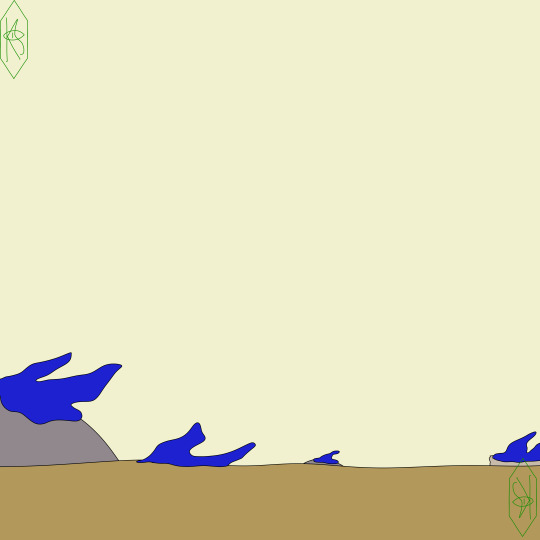
laspamallia, more commonly called a moss slime, are amorphous nodomusco, which grow on any solid surface, including sturdy sediment and other sedereamischos, the grow a filimentous layer of slime and will grow large extensions off of it which flow in the currents, they are a very common food item for almost every aquatic herbivorous seelenlos, and even terrestrial herbivores when they find it, they reproduce asexually through a mix of budding and regenerating their remains when they get eaten similar to telluric echinoderms, like most simple nodomusco they blur the line between colonial and multicellular, if you have any questions about this organism please dont be afraid to ask im more than happy to answer
#speculative biology#speculative botany#speculative evolution#speculative planet#speculative world#spec bio#spec botany#spec evo#spec planet#spec world#ngiu◗#exobiology#laspamallia#moss slime
7 notes
·
View notes
Text
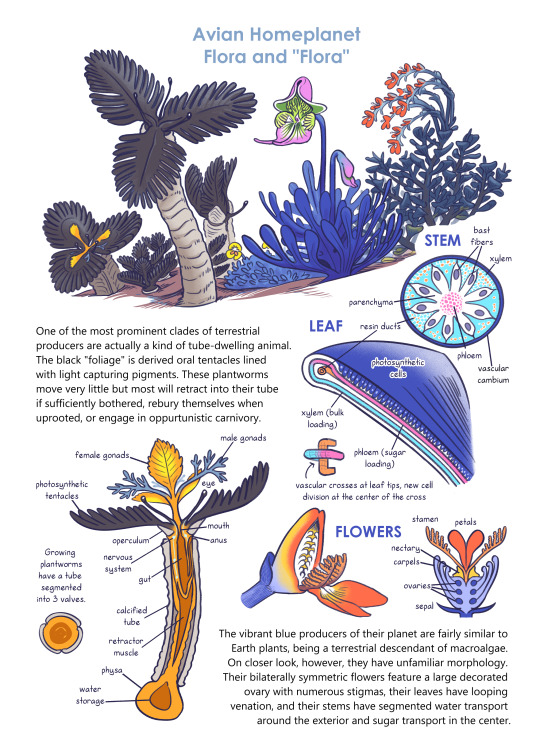
The avian homeplanet's plants, and worms pretending to be plants.
Plantworms tend to out-compete the true plants in wet climates with nutrient poor soil or unstable substrate (such as wetlands and rainforests) because of their opportunistic carnivory and mobility. The true plants out-compete them in arid climates (such as tundra and deserts) because they have more robust water gathering and anti-freezing mechanisms. While both can form mycorrhizal associations to aid in water and nutrient deliver through the soil, true plants have extensive root systems and are not completely reliant on rainwater and condensation in the absence of mycorrhizal partners.
Both plantworms and true plants have clades that partner with pollinator animals to reproduce, but some plantworm "flowers" are honey traps. They use their colorful genitals as a lure to snare and eat potential pollinators, and reproduce "the old fashioned way," as in, reaching over to their same species neighbors to exchange gametes.
I've posted a little about avian flora before, though this is more up-to-date.
PATREON | Runaway to the Stars
#runaway to the stars#speculative biology#whos here for some!!! FAKE PLANT CELLULAR PHYSIOLOGY!!! WHEEEEE#for the unfamiliar the cellular physio shown here is very weird and not similar to earth plants. things are kind of inverted#spec bio#spec evo#botany#avians#sort of
2K notes
·
View notes
Text
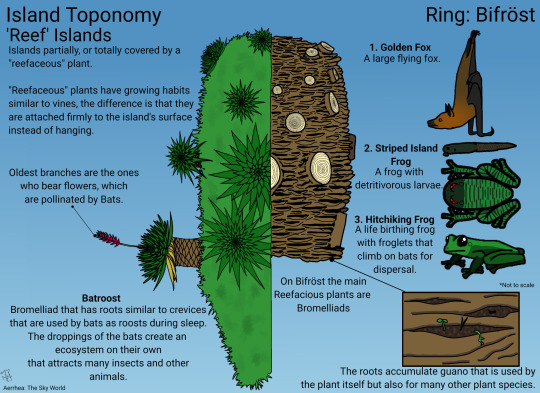
Island Toponomy
Ring: Bifröst
'Reef' Islands
'Reef' Islands are islands totally or mostly covered by "Reefaceous" or Reef-building plants, who here in Bifröst are Bromeliads.
These plants tend to be the foundation for other plants, gathering substrate for later species such as grasses, trees, etc. But also literal footing for animals not only moving from island to island but as in roosts or places to hide in. Thus they are called reefaceous/reef-builders, due to their ability to house in an ecosystem on their own within their roots.
Not all (in fact only a few) islands are completely reefaceous in nature as these kinds of plants tend to come later in the ecological succession of islands, competing fiercely with the wind-dispersed vines.
Individual Species Description
Batroost Creparophora insulobnubens (Crevice-Bearing Island-Coverer)
This plant is the type genus for not only its family but for Reef-building plants from Bifröst in general.
This plant starts out as a small, vividly colored, sweet fruit that is then consumed by animals such as bats, monkeys, goats and humans. Then carried within their stomachs to other islands where the small, hardy seeds contained within the droppings will hopefully get a strong footing to start growing many branches during its life. That is, in between the roots of other plants, including other Batroosts.
The plant itself starts to grow faster than trees but slower than the quick-growing vines, but fast enough to get a good grip on the surface of the island. Then, growing slowly over the years they spread across the island with their 'cracked' roots, collecting detritus and doing their namesake -serving as the roosts for bats.
Bats are definitely the most notorious of the daily users of this plant, using the roots to hang themselves upside down while covered by the many vines that grow over, and among the roots of the Batroost.
This is the case for the Golden Fox (Pteropus vulgaris Meaning "Common Foot Wing") which is a large, frugivorous bat from the same genus as the Flying Foxes from Earth, hence the "fox" in their name. The Golden Fox is a common (though not the only) dweller and user of these plants as roost. They not only benefits from the plant but the Batroosts also benefits from the bats, not only from the aforementioned nutrients found in their droppings (guano) but also to spread the seeds of the plant, as the fruit is a favorite meal of the bat.
However they are not the only animals to use this bromeliad, in fact many animals live their whole lives -or at least part of it- among the twisting crevices of the plant.
The Striped Island Frog (Vermigyrinus spp meaning "Worm Tadpole") is such an animal that lives part of its life among the roots of the Batroost. Although the adults live close by, hunting for insects and small vertebrates among the vines and trees, the larvae have a very specific niche. They don't necessarily need water to survive because they live in the concentrations of guano and decaying matter that accumulates in the crevices of the roots, a niche that is somewhat lacking in Aerrhea for one reason: There are no worms in this world. For whatever reason there are not annelids in Aerrhea (or at least in Bifröst) to live in and eat the humus of the shallow soil of islands, thus these frogs took this golden opportunity and exploited it. The Crevice micro-ecosystem is a well protected one and not explored by many as it is covered by thousands of vines, blocking the view of large predators and also their passage, offering a calm existence in these "pockets of nutrients" as far as "calm" can go in a constantly moving habitat. Which is also another pro for such a lifestyle as this is both a relatively competition-free ecosystem with many nutrients to consume.
The long tadpole can live for two weeks on their personal "terrariums" before metamorphosing into adults, climbing out of the roots' area and never returning again, at least that is the case for the males as the females after copulation (this species has internal fertilization) return to the crevices to lay 1-3 eggs -depending on the size of the crack and available detritus-, each on a different crevice to avoid competition among the larva and then leave them on their own until they grow into frogs and the cycle repeats again.
An example of an animal that lives its "whole" life among the nooks and crannies of the dark, understory is the Hitchhiking Frog (Viatoribus spp meaning "Passenger") who gets its name from its habits early in life. This tiny little frog also has internal fertilization, but instead of laying eggs they give birth to developed froglets whose voyage starts not long after being brought into this world. The mother frog, who lives by the crevices eating small invertebrates such as ants, climb upon roosting bats and give birth to their small versions of themselves, who using two opposing fingers grab onto the fur of their hosts and wait until they set flight again. This strategy is used due to the small size and vulnerability of these frogs, who use the larger bats as means of dispersing into other islands, giving a higher genetic diversity to these small ingenuous frogs.
#aerrhea#my art#worldbuilding#art#illustration#spec bio#speculative biology#spec evo#speculative evolution#speculative zoology#fantasy#speculative ecology#speculative worldbuilding#speculative botany
34 notes
·
View notes
Text

Should not be typing or anything with a overstrained hand but boredom is maddening so I needed to at least write a thing. So behold; Daily Month Art prompt list for those who may want to make Speculative Evolution art with plants specifically.
Short FAQ
What is SpecEvo?
*sneezes in wikipedia-ese link*
Does this art challenge have to be completed during September 2023 and in chronological order?
No and no; Can be done any month, of any year (hence the "plus" after 2023 title), in any order you wish. You can even just do one of the prompts that catches your eye and call it at that; Despite me creating this prompt list, it's your choice whether to add those rules in for yourself or not. I know all too well how both fun yet stressful art prompt lists can be.
Can I circulate this Prompt list beyond tumblr?
Please do! I made this specifically to get more peeps thinking of SpecEvo Flora concepts and I know tumblr is only one bubble of many others out there with SpecEvo artists lurking about. Credits are optional, since the prompt list image comes with my tumblr url anyhow.
Can I @ or tag you the OP if I participate in this promptlist?
While I don't expect this prompt list to reach far I'd rather play it safe and say no, please don't to avoid a potential albeit unlikely barrage of @ notifs. Besides I may end up lurking said tag if it starts being used, the tag #FloraSpectmbr will suffice (I have intentionally shorthanded/misspelled Spectember to make it distinct enough that it should *hopefully* avoid flooding the followed tags of those who are doing the unrelated Spectember prompt lists that already exist out there, plz follow that intentional mispelling if you're doing this Botanical Edition)
#FloraSpectmbr#spectember#SpecEvo#Spec Evo#art prompts#prompt list#plants#botany#art#Speculative Evolution#flora
27 notes
·
View notes
Text

I present to you, the surface temperature map of Jom'Gol during Northern Hemisphere Summer. This map took me DAYS and dozens of hours of work... and now i have to repeat it for winter too....
Legend is in the top left corner again, but every band of color is exactly 4.5 degrees Celsius. Some interesting spots on this map include the northern hemisphere's hottest average day temp of 46 degrees C (115 F), and the southern hemisphere's coldest average day temp of -107 degrees C (-160 F).
Due to the absolute size of the planet AND the continents, the uneven heating of the surface, biotic carbon cycles, and most importantly the fact that the axial tilt is 40 degrees, the temperature difference between regions can be quite extreme.
#art#digital art#artists on tumblr#worldbuilding#speculative biology#speculative evolution#spec bio#spec evo#jomgol#mapmaking#maps#digital painting#speculative worldbuilding#speculative botany#speculative zoology
9 notes
·
View notes
Text
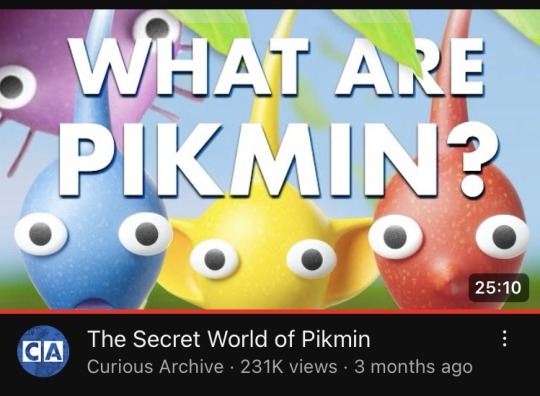
youtube
#curious archive#pikmin#pikmin 4#pikmin game#pikmin posting#pikmin series#pikmin fandom#pikmin nintendo#pikmin tag#speculative biology#speculative evolution#speculative zoology#specevo#spec evo#specbio#spec bio#spec zoo#speculative ecology#speculative botany#speculative worldbuilding#worldbuilding#worldbuilding stuff#nintendo#future evolution#gaming videos#gaming#video game#video games#gaming post#tumblr recommendations
11 notes
·
View notes
Text
The Kaikainuchwer Empire is more of a way of life, rather than any institution. Individuals on the islands and along the eastern coast happened to speak one language and engage in a similar code of ethics, but there is no one to uphold any laws or claim any dominion. Only permanent settlements by this point are coastal villages, where a reliable food source comes from the sea. These communities are ruled by the exchange of favors - for the food that fishers delivered, they are now owed the repair of their rafts by carpenters. Ancient caste of Mediators administering the transaction of favors and resolving any disputes, in exchange for their share of food and services. Mediators have to keep in mind all of the affairs and perform resource management, therefore mediators are very educated, developing an alphabet for the language and mathematics.
Their codependency makes Kaikainuchwer societies welcoming as long as nothing goes wrong, but not allowing for mistakes. If one’s duty was not performed, they get penalties, or get exiled, depending on the necessity of the failed task and severity of the failure. Sabotage of a neighbor's labor, if properly investigated, is a death sentence. Mediators, considered an unbiased part of society, also perform the role of executioners. While the villages are organized, there is never a larger force governing those. There were several pirate societies that tried to establish control over the coastal areas, but they suffered from infighting and rebellions and never lasted for a sagnificent time.

On the continent, the Kaikainuhwer spread over several climate zones. There are those who interact with jungle populations. These Kaikainuchwer must be the most inland of this culture. Savannah colonists are similar in their lives to islanders, because of the same climate, though they grow more militaristic with bigger predators and other Sutviprra tribes. When moving into temperate zones, they arrive into more forested areas and seas, abundant with big schools of fish, but temperatures become less comfortable. At first, they struggle to establish permanent settlements, but with arrival of North East Northern populations they manage to discover technology of clothes - unfortunately, the strategy used to open communication works no more - when winter closes in, resources get scarce and tribes become tense over territories they control. Kaikainuchwer, being smaller and less battleworthy get pushed into waterlogged areas of the forests, impossible to traverse if not for their rafts. Mostly subsisting on seafish in their diet, they also start to explore continental flora and fauna. Relatively late for Sutviprra, Kaikainuchwer started using throwing spears to hunt and forage for plants. In particular, they find plants, whose seeds are stored in pine-like clusters. This plant is very dependant on abundance of water and endemic to the north east swamps, and, if boiled in water, their pine becomes softer and possible to eat. They find it out because of animals, who also eat those pines, dip them in water to male it malleable, but there is also a myth.
Kaikainuchwer’s mythology/philosophy considers everything alive. They have a diverse array of rituals to worship or pacify every particular minor spirit, but main overincompasing entities are the sky and the sea. And so, once a continental Mediator was helping with a hunt, and witnessed a close lightning strike. Upon approach, she noticed that the entire batch of pine-plants shed their seeds, which were floating on the water surface. Suddenly, a lot of creatures, terrestrial, aquatic and flying started to feed on those seeds. The Mediator took this as a sign, took an uncooked pine home, boiled it and liked the resulting dish.
Later, when Kaikainuchwer started deliberately seeking and consuming it, it appeared to make them much healthier and stronger. It was attributed to special magical properties, real explanation was that their diet of mainly marine life brought dangerous levels of salt, mercury and made them develop overvitaminos.

#sutviprra#art#speculative biology#speculative evolution#worldbuilding#alien design#speculative botany#spec bio#spec evo#exobiology
8 notes
·
View notes
Text
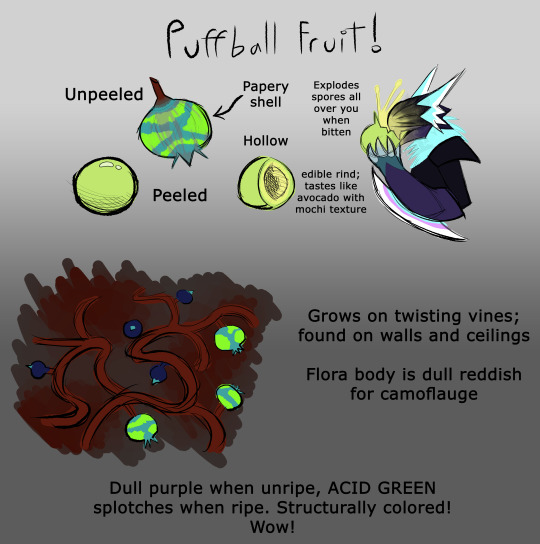
f u i t
Most of the flora in hell spread by spores of some kind; some of them are powdery (like these ones), others are sticky- but the common thread is that they are usually 'pollinated' by demons. Some flora do flower before fruiting, and thus require two-stage 'pollination' (fertilization, and then spreading of spores that will grow into new flora), but others are more like fungi. Generally, by various mechanisms, flora will get spores all over a demon- who will then spread the spores as they travel, kind of like burrs. Spreading by wind is almost completely unseen due to the lack of frequent or strong air currents in Hell.
The lack of animals in Hell ALSO includes such small animals as insects, which means Hell flora have evolved little means of defense against pests. At most, the bodies are tough and toxic to discourage predation, and unripe fruits are unpalatable and/or ALSO toxic. Because demons don't usually dip much below human size, and instead often range above that- fruit sizes tend to skew larger. Small berries are most common in flora with sticky spores, banking on getting all over a demon's hands when tediously harvested; however most fruits range from plum sized to watermelon sized.
These ones (puffball fruit) are more straight up fruit-like, and their hollow interior is filled with spores that explode out when the fruit is bitten. The 'explosion' is more a puff, and is not dangerous even to humans- though the fruit IS under pressure when it is ripe. Think shaken seltzer, but powder instead of liquid.
Green and blue are common advertising colors in Hell flora, as they stand out well against the browns, greys, muddy reds, and blacks of the caverns. They do NOT get their color from chlorophyll, however- there are NO photosynthetic flora in Hell, and instead flora are either chemosynthetic or thermosynthetic producers, or heterotrophic decomposers.
The main bodies of flora are often similar colors to the caverns they are found in, and as such are often fairly dull compared to the bright greens of Earth flora. Thermosynthetic flora however are usually black. Some flora use bioluminescence for advertising their fruits and flowers, and contribute noticeably to ambient lighting in Hell.
Due to the lack of day/night or seasonal cycles on the rogue planet, Hell flora tend to fruit continuously rather than in cycles; a given specimen may have a mixture of unripe fruits and ripe fruits simultaneously. Those that do grow in cycles are usually flowering varieties, for whom the strategy is to flower, THEN fruit so that demons do not skip pollinating flowers in favor of eating fruits. In flora that do fruit continuously, unripe fruits are dull but still somewhat distinct, as they can count on the advanced memory of sophont demons to draw them back to same flora later when the next batch is ripe.
Also I guess this is my new OC's debut, getting spored in the face while eating puffball fruit incredible
#in which Inc fucking spec bio botany's the fucking flora for a fantasy setting#inc's art#inc's ramblings#demon setting#puffball fruit#Hell flora#OC: Fluorospar
3 notes
·
View notes
Text
Hey guys, im still working on stuff!!!!

Im working on the next organism for my spec bio project!! The general concept for this organism is that they pollinate the seeds/spores of both the dome tree wnd the grape fungus, also making it a symbiote to the two. Though it is derived from plant ancestors, this fella adapted to use respiration instead of photsynthesis through random genetic mutations, therefore giving the dome tree a very good source of carbon!
I imagine theyd individually carry one large seed of the dome tree somewhere near its central body and a bunch of smaller grape fungus spores in the bristles located on its "legs". Uniquely, this species is able to move, and that, combined with the fact it uses respiration, makes it one of the earliest ancestors to plantimals on Fytikó! (To learn more about what plantimals are or what Fytikó is, check my pinned post :) )
Im not entirely sure yet on what the body plan for this creature should even be or how it should look; i know it would have some form of "legs" perhaps derived from plant roots, though im unsure if theyd walk upright (which wiuldnt be hard given the slightly lower gravity) or if they would just crawl along the ground starting off, similar to starfish. Below are a bunch of concepts for features and body layouts that they could have


Since dome trees need a lot of space to maximise the efficiency of photsynthesis, their offspring need to be planted far away, so this pollinator would have to carry these seeds far away. This may take lots of energy, but they also get lots of energy from leeching off of the grape fungi which in turn leech off of the nutrients of the dome tree. This pollinator both pollinates the offspring of the dome tree and the grape fungi, while also making sure that too many grape fungi dont grow on the dome tree, which would be bad since an overabundance of grape fungi could easily drain the tree of its nutrients. These pollinating lifeforms would be derived from parasitic plants, and would use a proboscis-like organ to inject into the sacks of grape fungi and to absorb their nutrients
Because theyd need to travel far to pollinate for the dome trees, and need to make their way back to their original host dome tree, they would both need at least some simple set of sensory organs which help them observe simple landscapes and remember the paths they travel - these organs would be analagous to brains and eyes, though far too simple to properly classify as such (they would later on develop to becime more complex, though)
Im not really sure how these organisms would reproduce themselves, like whether they should be hermaphroditic (given that they would spend much of their lives pollinating on their own), and im not sure if they should make one trip or two trips each time they pollinate, since dome trees might need to mature after being planted before they can afford to be surrounded by grape fungi. If these organisms would require to go back and forth from their original dome tree to the dome tree they had just planted, they may need a developed system analagous to a neural network so they can remember the exact path to reach both dome trees and go back and forth between one another, regardless of how much time has passed
----------------------------------
Sorry, i know these arent very good looking sketches, and im still very in the dark on how this organism should look or behave - i only have very vague and general ideas which are hard to put together. I am stubborn though, and will find one way or another to make the biology of this guy work. I hope nobodies been waiting to see any more from me, ill post the complete version of this pollinating organism once i have it done!! If anybody wants to help me design it too, feel free to comment or message me :) i just wanted to post these so people can get a more general idea of what i have in mind, and especially since it might take longer to design than the last two organisms i posted
#speculative evolution#spec bio#speculative biology#xenobiology#worldbuilding#spec evo#aliens#original species#speculative xenobiology#speculative botany#botany#concept art
13 notes
·
View notes
Text
Some concepts of "trees"on Maya1b

Essentially, all "trees" on this world are structures formed by symbiotic association between algae and a mass of colonial organisms, which has the added benefit of giving them a lot of these "plants" (especially smaller ones) nifty mixotrophic mode of nutrition, a trait pretty beneficial in the ever changing climate of this world
In essence this means, if things get really tough, the "plants" may in fact start becoming mobile and actively start hunting animals, blurring the lines between what constitutes a plant or not
How much of this behavior a plant shows varies from time to time & species to species
Oh this is how they're coloured btw

There's also a whole other story about their reproduction which is modelled after cnidarians and mosses buuuut thats a story for another time
4 notes
·
View notes
Video
n23_w1150 by Biodiversity Heritage Library
Via Flickr:
Gartenflora Erlangen :F. Enke,1852-1940. biodiversitylibrary.org/page/6671012
#Botany#Gardening#Germany#Periodicals#Plants#Ornamental#New York Botanical Garden#LuEsther T. Mertz Library#bhl:page=6671012#dc:identifier=https://biodiversitylibrary.org/page/6671012#flickr#Echinopsis Meyeri nov. spec. (Heese).#Echinopsis Meyeri#Echinopsis#hedgehog cactus#sea-urchin cactus#easter lily cactus#peanut cactus#cactus#succulents
4 notes
·
View notes
Text
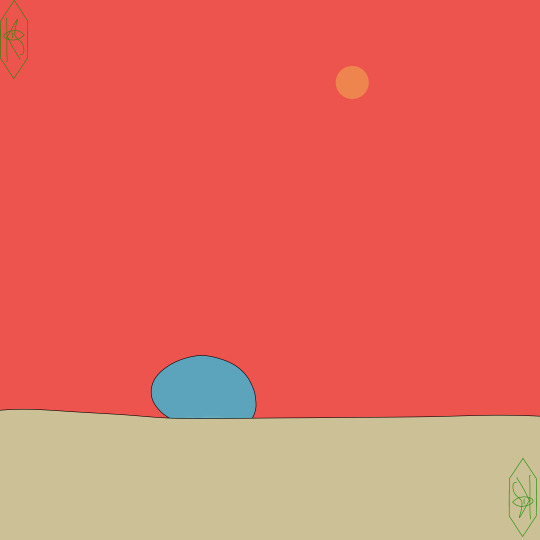

pachyrodiciphytes, more commonly called a tuber lump, these waxy sedereamischos litter the maschoran deserts and function much like telluric pando tree, being a clonal colony, there are still many individual colonies, but regardless a large amount of ramets will litter the surface of the maschoran deserts, under the sand their roots contain many tubers, and many desert dwelling ◗ta in the past used to farm parchyrodiciphytes for said tubers, for both consumption and feed for domesticated seelenlos, many seelenlos native to the maschoran deserts will dig up the sand around tuber lumps and eat said tubers, some organisms subsist entirely off of these tubers, such as desert worms, blight frills, and even young macrodermaderes, if you have any questions about this sedereamischos please dont be afraid to ask i am more than happy to answer
#speculative biology#speculative botany#speculative evolution#speculative planet#speculative world#spec bio#spec botany#spec evo#spec planet#spec world#ngiu◗#exobiology#pachyrodiciphytes#tuber lump
9 notes
·
View notes
Text
Orion D'Oschon

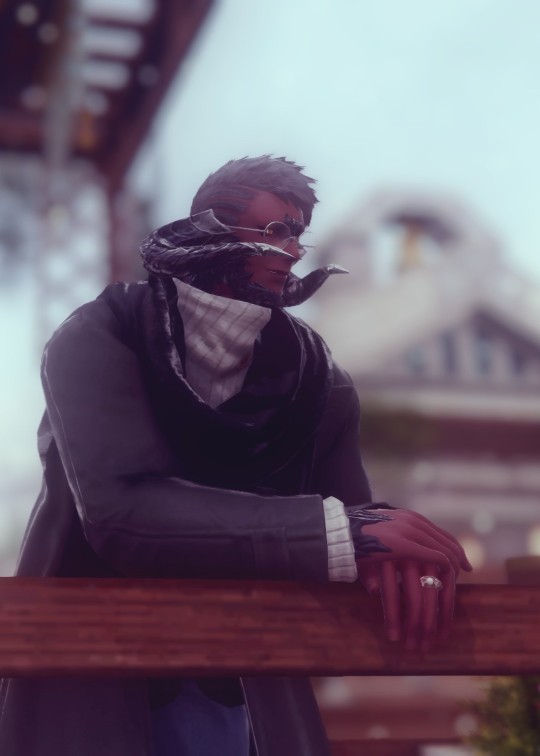
— B A S I C S
Name: Orion D'Oschon
Nicknames: Rion (mostly G'raha), Legs or Specs (mostly Kendra)
Age: 30ish
Nameday: 19th Sun of the 5th Astral Moon
Race: Xaela
Gender: Cis Male
Orientation: Bisexual
Profession: Warrior of Light, Aetherologist, part-time Historian, Botanist
— P H Y S I C A L A S P E C T S
Hair: Burnt Umber (Very dark reddish brown), kept short except for a section of braids along his right temple. Orion's hair is very thick and dense, giving a matte or velvet effect in the light.
Eyes: Amber with golden limbal rings
Skin: Umber (a bit lighter than his hair but in the same color family)
Tattoos/scars: He's got a pretty big scar running down his left leg from the fight with Zenos in Rhalger's Reach, small surgical scars around his knees from where he had to have reconstructive work done after Endwalker, and a small Mol clan tattoo on his inner wrist.
— F A M I L Y
Parents: Dolgoon Qestir (father) and Odsetseg Mol (mother). Both are alive and well and living in Ul'Dah. They also use the D'OSchon surname in Eorzea.
Siblings: None.
Grandparents: Temulun Mol
In-laws and Other: Cousin - Cirina Mol. Various other cousins, aunts, and uncles within the Mol tribe. No In-laws, Kendra doesn't have any living family.
Pets: Birdlegs (chocobo), Lily (Eos, she's not a pet, but she's important and I wanted to list her), Walpole (a very bitchy Carbuncle).
— S K I L L S
Abilities: SCH main (Scholar questline is canon for him), aetherology (he started his work with the Scions as Y'shtola's personal assistant), experienced and competent field medic, unique echo manifestation gives him the ability to see the flow of aether around him in a synesthesia-like effect.
Hobbies: Reading, astrology (learned from his mom), botany and gardening, botanical drawing, alchemy, helping Kendra in the kitchen, knitting, letter writing.
— T R A I T S
Most Positive Trait: Orion has an inquisitive mind. His desire, not only to know but to fully understand phenomena has led him to several ground-breaking discoveries. And he does not hoard knowledge. He'll enthusiastically share his findings with anyone who cares to listen. He is also just as inquisitive and keen to understand in social situations, making him an empathetic and open-minded person in general.
Most Negative Trait: Orion has a deep-seated distrust of governments and other institutions of traditional authority. This is not without reason, or even some merit, but it can make him difficult to work with when it comes to large-scale endeavors. His words or actions have nearly cost the Scions a deal more than once.
— L I K E S
Colors: Blue, especially woad, ink, and rhotano blue / Green / White / Warm browns / Metalics, especially gold.
Smells: Sandalwood, cedar, oolong tea, jasmine (reminds him of Kendra's perfume), libraries and well-preserved old paper, and morning fog in the Dravanian highlands.
Textures: The downy fur of Kendra's ears / yarn spun from the karakul of the Azim Steppe / well-loved leather-bound books / smooth, expertly-blown alchemical glassware.
Drinks: Tea, especially oolong or pu-erh. If Orion does not have access to actual pu-erh, he will make an equivalent with the darkest Sharlayan-style tea blend he can find, a custom blend of additives he will not divulge, and karakul milk. Just tasting it once put Urianger in a sickbed for two days. / Botanical spirits such as gin and aperitifs. He's even made a few himself.
— O T H E R D E T A I L S
Smokes: Medicinally smokes whatever variety of moko grass gets you stoned. He will also occasionally smoke tobacco socially, especially cigars.
Drinks: An adventurous but moderate drinker. He'll try anything at least once. He can occasionally be cajoled into heavier indulgence but that's abated as he's gotten older.
Drugs: There have been a few controlled "experiments" over the years.
Mount Issuance: Birdlegs is his primary mount that travels with him almost everywhere. The dusky, gigantic chocobo has become a bit of a legend in her own right. However, he does also technically have a yol as well, but has entrusted Cirina with his care because there's just not enough room on any of his properties for a bird of that size.
Been Arrested: For a mild-mannered professor type, Orion has been arrested so many times.
Tagged by:@ardberts🤍 tyyyy! Tagging: @physicalvocalist@sarenraegalpaladin@janzoo@airis-ray@ae-fond-seeker@captainqster@koijikido@adina--astra@iron-sparrow Sorry if you've already done this or been tagged before! I tried to pick mutuals I hadn't seen this from yet.
7 notes
·
View notes
Text
Transformers Yuletide Literary Fest - Day 10
Welcome to the Transformers Yuletide Literary Fest! I’ll be recommending one or two fics every day until Christmas. Feel free to join in if you’d like (I’m using the tag #tylf2023 for this.) All fics are complete!
(If I can easily find a Tumblr account for the author I’ll tag them. If you know of an author who has a Tumblr account and I didn’t tag them, please let me know so I can add it! )
Fics in my recommendations will come in two different flavours: tangy and spicy. 😄 As always, curate your own online reading experience, and mind the tags if necessary for your own safety. ♥
Tangy
Title: Spec Ops Mission 98: Jazz's Interrogation at Soundwave's Pedes
Author: @kc-anathema
Rating: Teen (contains plug-n-play interfacing)
Wordcount: 195, 290
Summary: Surrounded by the torrid fiction of his fellow Autobots, Jazz uncovers a Decepticon plot hidden amidst their written fantasies. Can the Spec Ops commander turn this plot of high treason into a narrative…of love? OR Jazz is surrounded by a bunch of perverted writers, and wouldn't you know it, one of them is a Decepticon.
Why I love it: This story left me stunned... in a good way. I started reading it as a WIP because the premise sounded hilarious (hahaha, the bots and cons are writing RPF fanfic about each other, hahaha). But as the story went on, it turned into a LOT more. It became a story about love and trust, and forgiveness and boundaries, set against the backdrop of a brutal war. And then when it ended and we got the wrap-up of all the threads that we hadn't even known existed... Wow. This was an amazing story, and I will definitely read it again someday.
Spicy
Title: The Angel Breaker
Author: @altraviolet
Rating: Explicit
Wordcount: 62,452
Summary: Mysterious, deadly creatures descend on the population of Cybertron, spreading a disfiguring, brainwashing disease. The wealthy retreat underground while the rest try to survive a dangerous and disrupted aboveground society.
Years after suffering a great personal loss, Drift works for Flatline doing menial tasks. But when Flatline sends him to find someone who has done the impossible – survive an attack – Drift finds himself swept up in a continent-spanning plot. To save the Cybertron they love, Drift and his allies must find out what these creatures are, who made them, and if they can be stopped.
Why I love it: One thing that I've always loved about Altraviolet's work is the worldbuilding. (If you've been paying attention at all to my recommendations over the past 10 days, you'll know that I LOVE me some good worldbuilding. 😄) This story has a wonderful amount, specifically focused on geology and botany, and their relation to culture. BUT ALSO it has a gripping story that sits on top of all that worldbuilding, with a "rare trio" that I never would have thought of myself, but it really works well here. The author has an excellent way of making sure each character has their own voice, and motivations, and hopes and fears, and then wraps it all up in story that somehow wouldn't feel out of place in a Mythology of Cybertron collection.
13 notes
·
View notes
Text
.................... I kinda wanna make a plant-themed spectember prompt list even though I know I can't participate in such a thing myself atm.
#ramblings#we need more botany-spec out there y'know what I mean?#it doesn't feel right for me to lead it since my spec-flora is in a fantasy setting rather than a sci-fi but still
3 notes
·
View notes
Text

I now present to you the surface temperature map of Jom'Gol, but for the Northern Hemisphere Winter this time. The legend is in the top left still, and each color isotherm is exactly 4.5 degrees Celsius.
We reach some new insane temperature records on this map, with several key spots of interest. Almost the same Northern Hemisphere region that reaches an average of 46 degrees C during the summer (115 F), reaches a temperature of -44 degrees C (-47 F). The colest NH spot being -84.5 C (-120 F).
A new amazing temperature record is set in the Southern Hemisphere, where temperatures reach an astounding average of 50.5 degrees C (123 F). Remember that these are an average full-day temperature, meaning that night temps are around 41 degrees C (105 F), and average non-heatwave, non-drought daytime temperatures are an average 60-62 degrees C (140 - 144 F).
Due to the size of the planet, the nature of its orbit, biotic carbon cycles, and exotic 40 degree axial tilt, the temperature differences between different spots on Jom'Gol remain drastically different.
#art#digital art#artists on tumblr#worldbuilding#speculative biology#speculative evolution#spec bio#spec evo#jomgol#digital painting#speculative worldbuilding#speculative botany#speculative zoology#mapmaking#maps#planets
9 notes
·
View notes